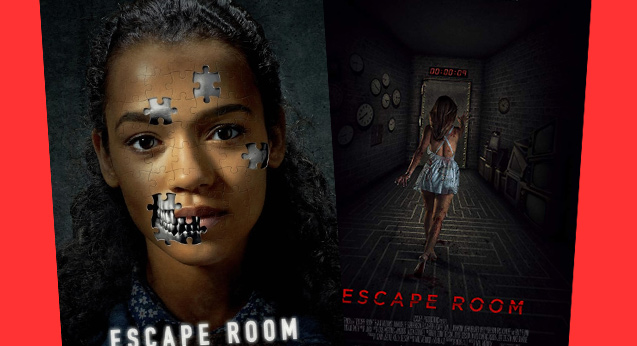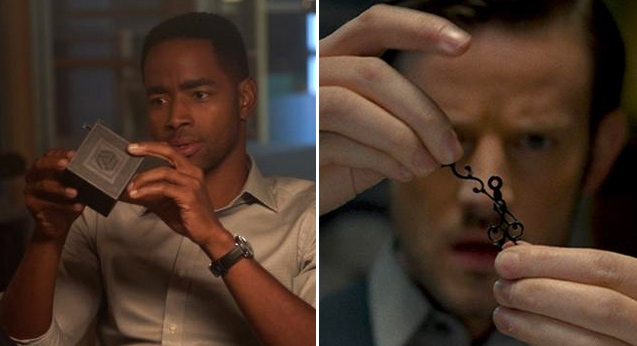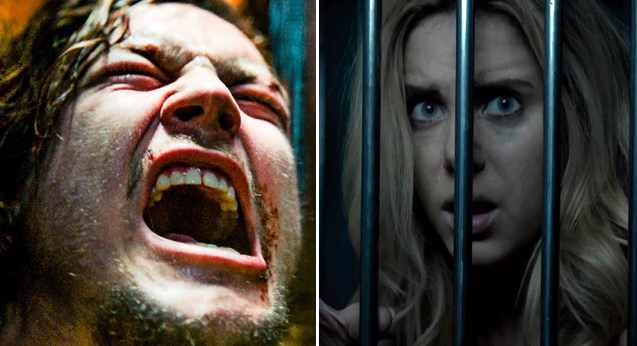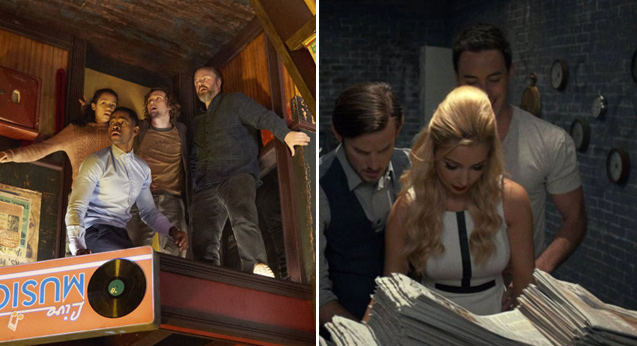Wait—there are TWO Escape Room films?
If your gonna see one, which one should it be?

“It’s like an actual escape room, except it’s REAL and the characters could DIE.” I’m guessing a heap of Hollywood producers had to hear this horror movie pitch within the last few years.
Statistically, some of them had to go “Yep, sounds good.” Now we’re in an awkward position where there are two escape room films called ‘Escape Room’ available to watch and—surprisingly—neither one’s a Blumhouse Production. The cinematic release comes from Sony Pictures, which I’ll call Sony’s Escape Room. The straight-to-VOD offering comes from Escape Productions, which I’ll call—erm—Escape’s Escape Room, I guess.
It may seem bleedingly obvious to you which film’s gonna be the better of the two, but you never want to judge a film by its poster. Or its trailer. Or its studio’s name. Or its distribution method. Or what an internet film critic like me has to say about them.
Nevertheless, I’m an internet film critic, and I’ve got things to say about them. Which Escape Room is the better Escape Room, in my blunt opinion? I graded each based on five different criteria.

Sony’s Escape Room (left) & Escape’s Escape Room (right)
The characters
Sony’s Escape Room sees six strangers compete in a mysterious escape room with the promise of a lumpy cash prize. They’re a culturally diverse lot, traversing different ages and economic classes, and the film gets props for giving each of them a rounded backstory. One girl’s a tertiary genius still reeling from the trauma of a plane crash. There’s an extremely likeable middle-aged truckie who takes part for the sake of his son. And Daredevil‘s Deborah Ann Woll plays an army vet who really just needs the cash.
Escape’s Escape Room is pretty much filled with rich white people attending a super exclusive escape room as a gift to a birthday boy who showed absolutely no interest in such things (he rolls with it anyway to please his unthoughtful girlfriend). There’s hardly anything to define his group. One’s his sister, and we know this because her first word of dialogue is “Brother!” Another’s her boyfriend, a grinning GMO hybrid of Billy Zane and Paul Walker (pictured above and to the right). There’s also an Asian American woman in the group, but she doesn’t attend the escape room because she had a “sexy party” to go to.
Ultimately, one of these films builds its characters up well enough to make you feel somewhat bad about their death. That film definitely isn’t Escape’s Escape Room.
Winner: Sony’s Escape Room

Sony’s Escape Room (left) & Escape’s Escape Room (right)
The direction
Will Wernick, director of Escape’s Escape Room, clearly took the rusty handle from the Saw franchise when etching the look for his film—right down to a blood-red countdown timer. Set completely at night, the colour palette achieves fifty shades of mould that’s generally unappealing though the modest set-dressing feels more in line with what an actual escape room would look like.
Adam Robitel, director of Sony Escape Room, takes a refreshingly different approach by giving each escape room a specific theme and colour palette. He shoots for scope, not claustrophobia, which makes the characters—not their cage—feel small. The reason for this reversal becomes clearer as the film goes on and Robitel stays playful with camera movements and audio cues.
Winner: Sony’s Escape Room

Sony’s Escape Room (left) & Escape’s Escape Room (right)
The tension
Sony’s Escape Room may have avoided an R-rating, but that doesn’t strip it of its thrills. Part of the tension it earns comes from the character work previously mentioned. You genuinely care for these people and don’t want them to die, and while no-one gets their head split in five, the kills aren’t pleasant. The film also clearly establishes what these characters have to do to survive, so any action that might not achieve the goal effectively adds to the tension.
Escape’s Escape Room cheats. A character might do the right thing and die anyway. Or they might be a total moron and get themselves killed for not doing the blatantly obvious thing to do in a life-or-death situation. There’s a reason we laugh at the Darwin awards, and as such, those behaviours have no place in self-serious horror films. One particular kill comes off gratuitously cruel, too.
Winner: Sony’s Escape Room

Sony’s Escape Room (left) & Escape’s Escape Room (right)
The actual escape rooms
While it’s somewhat cool that Escape’s Escape Room‘s escape rooms are more representative of real-life escape rooms, key parts to the puzzles remain hidden to the viewer, leaving only the characters to solve it. Part of the fun of watching whodunit mysteries is trying to work out who done it (duh), but if the suspects aren’t even introduced, it becomes as dull as listening to someone solve a Rubik’s Cube. That’s essentially how Escape’s Escape Room fumbles the ball.
Sony’s Escape Room occasionally violates this rule, too. However, there are enough instances where the answer can be worked out moments before the characters click onto the solution. The rooms also end up being more distinctive and thematically relevant in their own ways, though one particular flashy room should probably come with an epilepsy warning.
Winner: Sony’s Escape Room

The endings (spoiler-free)
Sony’s Escape Room flirts with a creeping Cube-like ending where nothing’s entirely explained, and it would have been so much better for it. Instead, the ending tries to explain as much as it can, and the more it does, the more laughable it gets. And it keeps going. And going. And going. It’s like watching a clown car crash in slow motion.
Escape’s Escape Room, however, does attempt the aforementioned Cube ending, but you know it wasn’t intentional. Rather, it comes across like the writer couldn’t make the premise work in the first place, ending with a Philosophy 101 student’s rush-job conclusion that goes something like: “Well, you could say life is its own escape room.”





















